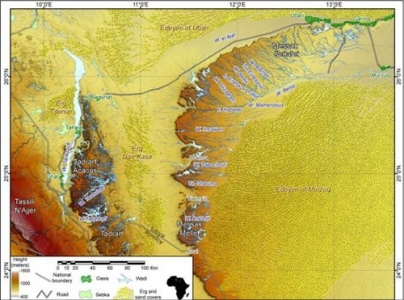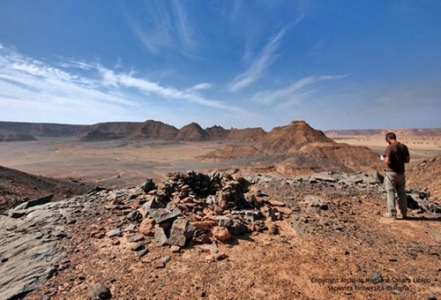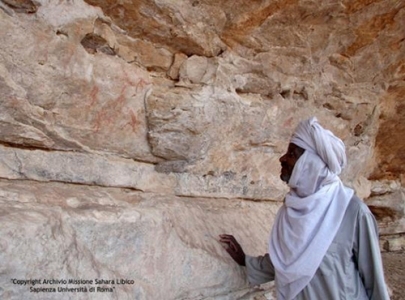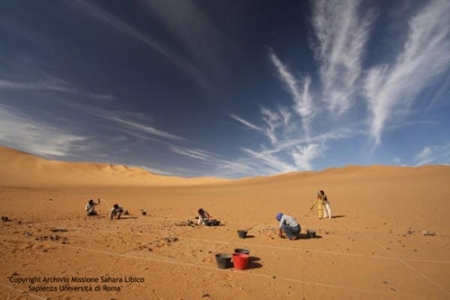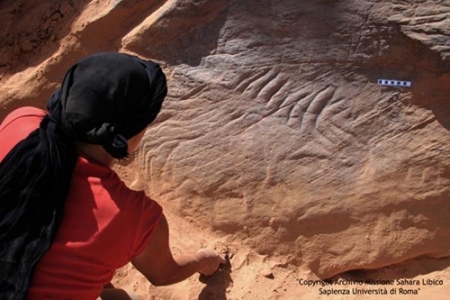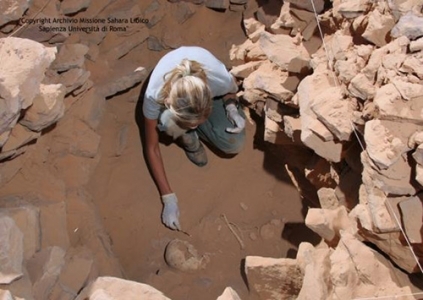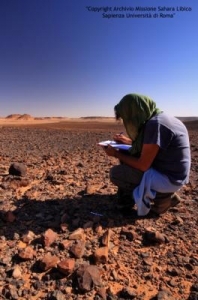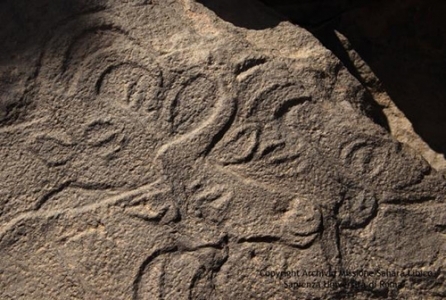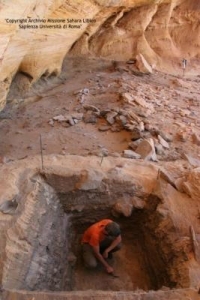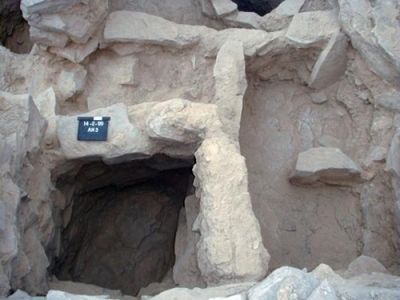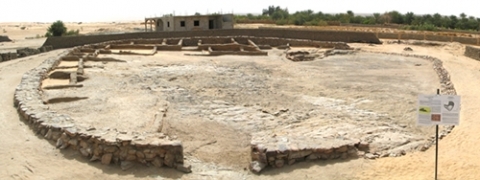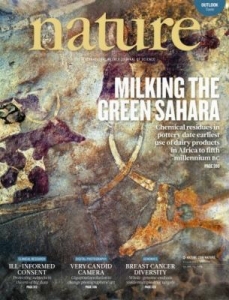
Missione archeologica nel Sahara (Libia, Algeria, Tunisia)
Fondata nel 1955, la Missione Archeologica nel Sahara raccoglie l’eredità della “Missione Archeologica Italo-Libica nell’Acacus e Messak (Sahara Centrale)” e rappresenta una delle più longeve realtà nel panorama dell’archeologia sahariana. Dedicata inizialmente allo studio delle pitture rupestri del Tadrart Acacus (nel 1985 inserite nella World Heritage List dell’UNESCO), la Missione ha progressivamente intensificato l’integrazione di diverse discipline, dalla geoarcheologia alla paleoantropologia, fino all’etnoarcheologia ed alla storia recente. L’area di studio, che comprende la zona centrale del Sahara, costituisce un eccellente laboratorio per l’esplorazione delle dinamiche del rapporto tra società umane e fluttuazioni climatiche, dal Pleistocene ai giorni nostri. Uno spazio non secondario è dedicato alla salvaguardia del patrimonio archeologico sahariano, e ad operazioni di archeologica preventiva e d’emergenza. La missione pubblica inoltre la propria serie di monografie ‘Arid Zone Archaeology’, e vari articoli sono apparsi sulle riviste accademiche più prestigiose e diffuse.
- Ait Kaci, A. 2007. Recherche sur l'ancêtre des alphabets libyco-berbères. Libyan Studies 38:13-37.
- Biagetti, S., A. Ait Kaci, L. Mori, and S. di Lernia. 2012. Writing the desert. The ‘Tifinagh’ rock inscriptions of the Tadrart Acacus (south-west Libya). Azania 47:153-174.
- Biagetti, S., and J. M. Chalcraft. 2012. Imagining Aridity: Human-Environment Interactions in the Acacus Mountains, South-West Libya in Imagining Landscapes: Past, Present, and Future, Anthropological Studies of Creativity and Perception. Edited by M. Janowski and T. Ingold, pp. 77-95. Farnham: Asghate.
- Biagetti, S., S. di Lernia, and G. Poggi. 2009. Unearthing the hearths. Preliminary results on the Takarkori rockshelter fireplaces (Acacus Mts., Libya). in Proceedings of the XV UISPP Conference (Lisbon, 4-9 settembre 2006), vol. BAR S2045. Edited by F. Cavulli, M. I. Prudêncio, and M. I. Dias, pp. 23-29. Oxford: Archaeopress.
- Cancellieri, E., M. Cremaschi, A. Zerboni, and S. di Lernia. in press. Climate, Environment and Population Dynamics in Pleistocene Sahara in Africa from Marine Isotope Stages 6-2: population dynamics and paleoenvironments. Vertebrate Paleobiology and Paleoanthropology Series. Edited by S. Johnes and B. Steward: Springer.
- Cancellieri, E., and S. di Lernia. in press. Middle Stone Age human occupation and dispersals. New data from the Messak plateau (SW Libya, central Sahara). Quaternary International.
- Cremaschi, M., and A. Zerboni. 2009. Early to Middle Holocene landscape exploitation in a drying environment: two case studies compared from the central Sahara (SW Fezzan, Libya). C. R. Geosci 341:689-702.
- —. 2011. Human communities in a drying landscape. Holocene climate change and cultural response in the central Sahara in Landscape and Societies. Edited by I. P. Martini and W. Chesworth, pp. 67-89. Dordrecht Heidelberg London New York: Springer Science.
- Cremaschi, M., A. Zerboni, C. Spötl, and F. Felletti. 2010. The calcareous tufa in the Tadrart Acacus Mt. (SW Fezzan, Libya). An early Holocene palaeoclimate archive in the central Sahara. Palaeogeography, Palaeoclimatology, Palaeoecology 287:81-94.
- di Lernia, S. in press. The emergence and spread of herding in Northern Africa: a critical reappraisal in Oxford Handbook of African Archaeology. Edited by P. J. Mitchell and P. J. Lane. Oxford: Oxford University Press.
- di Lernia, S., and M. Gallinaro. 2010. The date and context of Neolithic rock art in the Sahara: engravings and ceremonial monuments from Messak Settafet (south-west Libya). Antiquity 84:954-975.
- —. 2011. Working in a UNESCO WH site. Problems and practices on the rock art of the Tadrart Acacus (SW Libya, central Sahara). Journal of African Archaeology 9:159-175.
- di Lernia, S., M. Gallinaro, and A. Zerboni. 2010. Unesco Word Heritage Site vandalized. Report on damages to Acacus rock art paintings (SW Libya). Sahara 21:59-76.
- di Lernia, S., I. Massamba N'siala, and A. M. Mercuri. 2012. Saharan prehistoric basketry. Archaeological and archaeobotanical analysis of the early-middle Holocene assemblage from Takarkori (Acacus Mts., SW Libya). Journal of Archaeological Science 39:1837-1853.
- di Lernia, S., I. Massamba N'Siala, and A. Zerboni. 2012. ‘Saharan Waterscapes’. Traditional Knowledge and Historical Depth of Water Management in the Akakus Mts. (SW Libya) in Changing Deserts: Integrating People and their Environment. Edited by L. Mol and T. Sternberg, pp. 101-128. Cambridge: The White Horse Press.
- di Lernia, S., L. Mori, and A. Zerboni. 2008. Geo-archaeological survey in the Kufra Eni contract area (Eastern Sahara, SE Libya). Sahara 19:7-26.
- di Lernia, S., and M. A. Tafuri. in press. Persistent deathplaces and mobile landmarks. The Holocene mortuary and isotopic record from Wadi Takarkori (SW Libya). Journal of Anthropological Archaeology.
- Gallinaro, M., C. Gauthier, G. Gauthier, J.-L. Le Quellec, S. Abdel Aziz, S. Biagetti, L. Boitani, E. Cancellieri, L. Cavorsi, I. Massamba N'Siala, A. Monaco, A. Vanzetti, A. Zerboni, and S. di Lernia. 2012. The Messak Project. Cultural and Natural Preservation and Sustainable Tourism (south-western Libya) in Antiquity Project Gallery, vol. 086.
- Mercuri, A. M. 2008a. Human influence, plant landscape evolution and climate inferences from the archaeobotanical records of the Wadi Teshuinat area (Libyan Sahara). Journal of Arid Environments 72:1950-1967.
- —. 2008b. Plant exploitation and ethnopalynological evidence from the Wadi Teshuinat area (Tadrart Acacus, Libyan Sahara). Journal of Archaeological Science 35:1619-1642.
- Mercuri, A. M., L. Sadori, and P. Uzquiamo Ollero. 2011. Mediterranean and north-African cultural adaptations to mid-Holocene environmental and climatic changes. The Holocene 21:189-206.
- Olmi, L., A. M. Mercuri, M. T. P. Gilbert, S. Biagetti, S. Fordyce, E. Cappellini, I. Massamba N’siala, and S. di Lernia. 2011. Morphological and geneticanalyses of early-mid Holocene wild cereals from the Takarkori rockshelter (central Sahara, Libya): first results and prospects in Windows on the African Past: Contemporary Approaches to African Archaeobotany, Reports in African Archaeology. Edited by A. G. Fahmy, S. Kahlheber, and A. C. D’Andrea, pp. 175-184. Frankfurt Africa Magna Verlag.
- Perego, A., A. Zerboni, and M. Cremaschi. 2011. The geomorphological map of the Messak Settafet and Mellet (Central Sahara, SW Libya). Journal of Maps v2011: 464-475.
- Zerboni, A. 2008. Holocene rock varnish on the Messak plateau (Libyan Sahara): chronology of weathering processes. Geomorphology 102:640-651.
- —. 2011. An early Holocene transitory arid phase in the central Sahara at the time of the 8.2 Ky BP climate anomaly. Il Quaternario 24:225-227.
- Zerboni, A., L. Trombino, and M. Cremaschi. 2011. Micromorphological approach to polycyclic pedogenesis on the Messak Settafet plateau (central Sahara): Formative processes and palaeoenvironmental significance. Geomorphology 125:319-335.
- Grandi Scavi d’Ateneo (Sapienza)
- DGPCC (Ministero Affari Esteri)
- Enti privati
Premi e riconoscimenti:
- Premio “Giorgio Maria Sangiorgi” per la Storia ed Etnologia dell’Africa (Accademia Nazionale dei Lincei), assegnato nel 2012 a Savino di Lernia
- Certificate of Appreciation, Ministry of Culture, Libya, 2012



